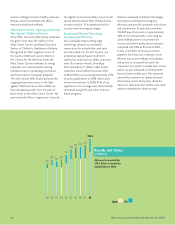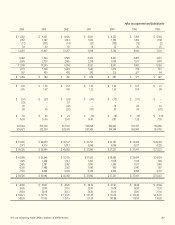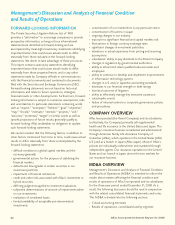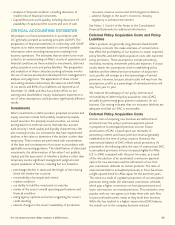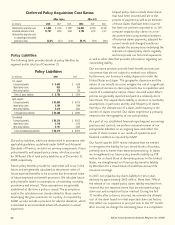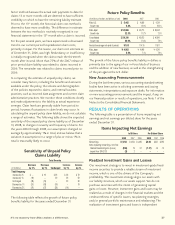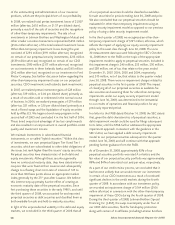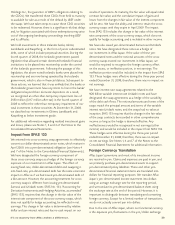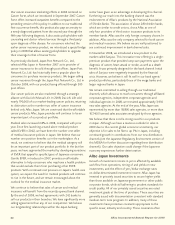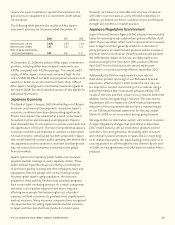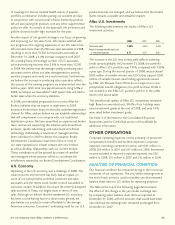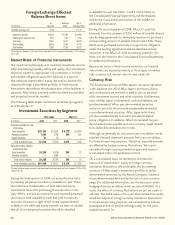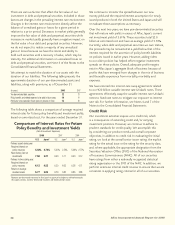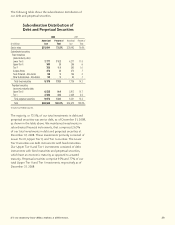Aflac 2008 Annual Report Download - page 34
Download and view the complete annual report
Please find page 34 of the 2008 Aflac annual report below. You can navigate through the pages in the report by either clicking on the pages listed below, or by using the keyword search tool below to find specific information within the annual report.
30 Aflac Incorporated Annual Report for 2008
rate can have a significant effect on our reported results. In
periods when the yen weakens, translating yen into dollars
results in fewer dollars being reported. When the yen
strengthens, translating yen into dollars results in more dollars
being reported. Consequently, yen weakening has the effect
of suppressing current year results in relation to the prior
year, while yen strengthening has the effect of magnifying
current year results in relation to the prior year. As a result,
we view foreign currency translation as a financial reporting
issue for Aflac and not an economic event to our Company
or shareholders. Because changes in exchange rates distort
the growth rates of our operations, management evaluates
Aflac’s financial performance, excluding the impact of foreign
currency translation.
Income Taxes
Our combined U.S. and Japanese effective income tax rate
on pretax earnings was 34.5% in 2008, 34.6% in 2007 and
34.5% in 2006. Total income taxes were $660 million
in 2008, compared with $865 million in 2007 and $781
million in 2006. Japanese income taxes on Aflac Japan’s
results account for most of our consolidated income tax
expense. See Note 8 of the Notes to the Consolidated
Financial Statements for additional information.
INSURANCE OPERATIONS
Aflac’s insurance business consists of two segments:
Aflac Japan and Aflac U.S. Aflac Japan, which operates
as a branch of Aflac, is the principal contributor to
consolidated earnings. GAAP financial reporting
requires that a company report financial and descriptive
information about operating segments in its annual
financial statements. Furthermore, we are required to
report a measure of segment profit or loss, certain
revenue and expense items, and segment assets.
We measure and evaluate our insurance segments’
financial performance using operating earnings on a
pretax basis. We define segment operating earnings
as the profits we derive from our operations before
realized investment gains and losses, the impact from
SFAS 133, and nonrecurring items. We believe that
an analysis of segment pretax operating earnings is
vitally important to an understanding of the underlying
profitability drivers and trends of our insurance
business. Furthermore, because a significant portion
of our business is conducted in Japan, we believe it is
equally important to understand the impact of translating
Japanese yen into U.S. dollars.
We evaluate our sales efforts using new annualized premium
sales, an industry operating measure. Total new annualized
premium sales, which include new sales and the incremental
increase in premiums due to conversions, represent the
premiums that we would collect over a 12-month period,
assuming the policies remain in force. For Aflac Japan, total
new annualized premium sales are determined by applications
written during the reporting period. For Aflac U.S., total new
annualized premium sales are determined by applications that
are accepted during the reporting period. Premium income,
or earned premiums, is a financial performance measure that
reflects collected or due premiums that have been earned
ratably on policies in force during the reporting period.
AFLAC JAPAN SEGMENT
Aflac Japan Pretax Operating Earnings
Changes in Aflac Japan’s pretax operating earnings and
profit margins are primarily affected by morbidity, mortality,
expenses, persistency and investment yields. The following
table presents a summary of operating results for Aflac Japan.
The percentage increases in premium income reflect the
growth of premiums in force. The increases in annualized
premiums in force in yen of 3.2% in 2008, 3.9% in 2007
and 5.4% in 2006 reflect the high persistency of Aflac
Japan’s business and the sales of new policies. Annualized
Aflac Japan Summary of Operating Results
(In millions) 2008 2007 2006
Premium income $ 10,674 $ 9,037 $ 8,762
Net investment income:
Yen-denominated investment income 1,312 1,102 1,064
Dollar-denominated investment income 741 699 624
Net investment income 2,053 1,801 1,688
Other income 15 27 25
Total operating revenues 12,742 10,865 10,475
Benefits and claims 7,972 6,935 6,847
Operating expenses:
Amortization of deferred policy acquisition costs 405 318 285
Insurance commissions 970 850 859
Insurance and other expenses 1,145 941 832
Total operating expenses 2,520 2,109 1,976
Total benefits and expenses 10,492 9,044 8,823
Pretax operating earnings* $ 2,250 $ 1,821 $ 1,652
Weighted-average yen/dollar exchange rate 103.46 117.93 116.31
In Dollars In Yen
Percentage change over
previous year: 2008 2007 2006 2008 2007 2006
Premium income 18.1% 3.1% .2% 3.5% 4.3% 5.9%
Net investment income 14.0 6.7 3.2 – 8.0 9.0
Total operating revenues 17.3 3.7 .6 2.8 4.9 6.3
Pretax operating earnings* 23.6 10.2 9.1 8.4 11.8 15.4
*See our definition of segment operating earnings at left.


